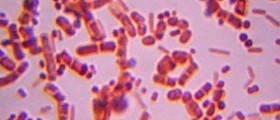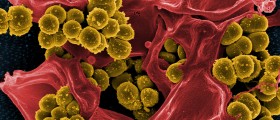
Staphylococcus is a group of bacteria that can lead to a majority of infections of different organs and organ systems in the body. These infections can be mild and some of them are rather serious and potentially life-threatening.
The name of these bacteria originates from their appearance under microscope. They actually resemble grapes or berries. The Greek word for grapes is staphyle hence the name. Even though there are around 30 different types of Staphylococcus which cause infections in humans definitely the leading one is Staphylococcus aureus. Some people may be carriers of these bacteria. In them the bacteria can be located in the nose or on the skin. These people will have no signs of the disease until an injury occurs and the bacterium enters the nearby tissues.
Infections caused by Staphylococci can occur in each and every person. Still, there are groups that are more susceptible to the infection comparing to general population. Newborn babies, breastfeeding women and people who are suffering from chronic illnesses are at higher risk to develop Staphylococcus aureus infections. Additionally, risk increases in intravenous drug abusers, people who are suffering from certain skin disorders where the continuity of the skin is affected as well as people with weak immune system.
Symptoms and Signs of Staphylococcus Infection
If the infection is localized only to the skin it features with collections of puss. These collections can be in a form of a furuncle or more serious abscesses. The affected area is painful, swollen and red.
In case that bacterium enters the blood stream sepsis occurs. Sepsis is a life-threatening condition which features with fever and chills, low blood pressure and fast heart rate. If not diagnosed and treated on time a patient may develop septic shock and eventually die.
Type of Infections Caused by Staphylococcus Aureus
Skin infections are the leading infections caused by these bacteria. The infection can only affect the superficial layers of the skin or even progress and cause impetigo, cellulitis and abscesses. In women who are breastfeeding Staphylococcus aureus can cause mastitis or an abscess of the affected breast.
After the bacteria have entered the blood stream it can affect numerous organs. The presence of the bacteria in the blood is called bacteriemia or sepsis. The bacteria can reach the lungs and in predisposed people leads to lung abscesses. If the heart valves are affected endocarditis occurs. If the bacterium affects the bones osteomyelitis develops.
In case that blood is infected with this bacterium sepsis occurs. Bacterial sepsis due to Staphylococcus aureus is the leading cause of lethal outcome in people suffering from severe burns. In rather rare cases Staphylococcus auresu can also cause neonatal sepsis in pregnancy.
Another form of an infection caused by this bacterium is food poisoning. The symptoms and signs of food poisoning are related to the very bacterial toxins.
And finally, a toxic shock syndrome is another form of the disease caused by this bacterium. It occurs in women who use tampons.

















Your thoughts on this
Loading...